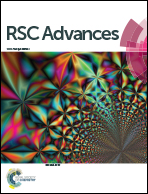Vinylene and benzo[c][1,2,5]thiadiazole: effect of the π-spacer unit on the properties of bis(2-oxoindolin-3-ylidene)-benzodifuran-dione containing polymers for n-channel organic field-effect transistors†
Abstract
Two polymers based on (3E,7E)-3,7-bis(2-oxoindolin-3-ylidene)benzo[1,2-b:4,5-b′]difuran-2,6(3H,7H)-dione (BIBDF) coupled with (E)-2-(2-(thiophen-2-yl)vinyl)thiophene (TVT) or dithienylbenzothiadiazole (TBT), namely PBIBDF-TVT and PBIBDF-TBT were synthesized via the Stille coupling reaction. The effect of benzothiadiazole or vinylene-π spacer of the copolymers on optical properties, energy levels, electronic device performance and microstructure were studied. It was found that PBIBDF-TBT based OFET devices, annealed at 180 °C, showed better performance with the highest electron mobility of 2.9 × 10−2 cm2 V s−1 whereas PBIBDF-TVT polymer exhibited 5.0 × 10−4 cm2 V s−1. The two orders of magnitude higher electron mobility of PBIBDF-TBT over PBIBDT-TVT is a clear indicator of the better charge transport ability of this polymer semiconductor arising from its higher crystallinity and better donor–acceptor interaction.
![Graphical abstract: Vinylene and benzo[c][1,2,5]thiadiazole: effect of the π-spacer unit on the properties of bis(2-oxoindolin-3-ylidene)-benzodifuran-dione containing polymers for n-channel organic field-effect transistors](/en/Image/Get?imageInfo.ImageType=GA&imageInfo.ImageIdentifier.ManuscriptID=C8RA08890J&imageInfo.ImageIdentifier.Year=2018)


 Please wait while we load your content...
Please wait while we load your content...